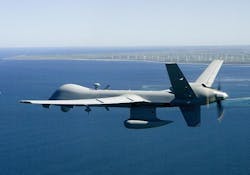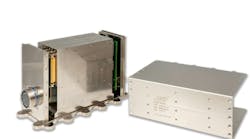WASHINGTON, 17 Aug. 2013.General Atomics Aeronautical Systems Inc. (GA‑ASI), maker of remotely piloted aircraft (RPA), tactical reconnaissance radars, and electro-optic surveillance systems, demonstrated the Predator Bunmanned aerial vehicle’s (UAV’s) electronic attack capability.
The purpose of the demonstration was to evaluate the viability of an RPA to conduct electronic warfare missions against enemy air defenses in support of tactical strike aircraft. GA-ASI participated with a company-owned Predator B RPA equipped with a jamming pod containing a Northrop Grumman Digital Receiver/Exciter and controlled by a GA-ASI Ground Control Station (GCS).
Predator B was integrated into the advanced Command and Control (C2) networks and electronic warfare (EW) architecture of the exercise, with more than 20 aircraft participating. The Northrop Grumman payload proved to be effective and seamlessly integrated with the Predator B avionics, command and control architecture.
“With this highly effective display of Predator B as a viable and capable EW platform, we are poised to provide even greater value as a multimission RPA solution for the Marines to address their EW requirements,” explains GA-ASI Aircraft Systems Group President Frank W. Pace.
The demonstration took place 12 April 2013 at the U.S. Marine Corp’s (USMC’s) Weapons and Tactics Instructor (WTI) course held at Marine Corp Air Station (MCAS) Yuma.
Future demonstrations will expand on the success and lessons learned from the use of Predator B to execute a multi-node approach against a more capable Integrated Air Defense System (IADS) in concert with other unmanned aircraft systems (UAS) and EA-6B Prowlers in future training exercises.
Future demonstrations will focus on a more integrated and networked EW capability, expanding the C2 network to direct the aircraft’s EW payload and other assets from the Cyber/Electronic Warfare Coordination Cell (C/EWCC) at MCAS Yuma. In future demonstrations, the C/EWCC will support large aircraft strike packages addressing simulated targets over 300 miles north located at Naval Air Weapons Station, China Lake.
“We are using multiple platforms in a networked approach to prosecute the IADS to protect our strikers as they hit their targets,” describes Major Charles Dudik, HQMC Aviation EW Requirements Officer. “It is a non-traditional approach to this problem set, but we believe this is where the future is headed for EW.”
An advanced derivative of the combat-proven Predator, the multimission Predator B provides essential situational awareness for warfighters, excelling in combat missions focusing on intelligence, surveillance, and reconnaissance (ISR), precision strike on time-sensitive targets, close air support (CAS), signals intelligence (SIGINT), forward air control (FAC), improvised explosive device (IED) detection, bomb damage assessment (BDA), and now airborne electronic attack.



